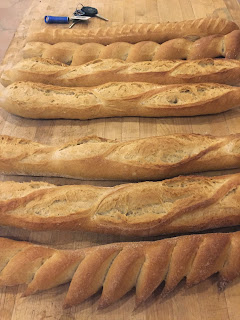Had the soft opening on Friday. The breads came out well. My main notes were that the country loaves were inconsistent and the ears did not open up on most of them. I did baguette, focaccia, country loaves and whole wheat with fruit and nuts. Over the last few days I have tried some various incarnations of country/sourdough loaves, including Bouchon's Pain Campagne.
Pain Campagne #1:
69% hydration, 5% whole wheat and 5% rye. 33% levain and .1% yeast. 3 hour bulk fermentation, 1 hour final proof.
Tried various shapes. The raises percentage of levain added some good shelf life, and the flavor was nice, only mildly acidic. Crumb was a little tighter than I would like.



Sourdough #5:
58% levain, 10% whole wheat and 10% rye. 2.5 hour bulk fermentation, 1.5 hour final proof.
This is a different technique to achieve an acidic tasting dough. Previously I have taken my Pain Levain formula which has a relatively low amount of preferment(20% levain compared to the amount of flour) and letting it cold proof overnight. This long, slow proof essentially lets the acetic and lactic acids from my levain build and fill the rest of the dough. For this recipe I start with a much higher percentage of levain, and go for a shorter proof. In this way it is almost like a cheat-recipe - instead of seeding the dough with a little levain and let it naturally grow, you add more levain from the beginning.
The depth of flavor was not the same as a long slow ferment, however it was pretty damn good and this recipe will come in handy if I am in a situation where I don't have 10 hours to make a bread.


Seeded Whole Wheat #4:
10% whole wheat flour, 10% rye flour. 33% levain. Sesame, flax, walnut and pumpkin seeds.
This was essentially a campagna dough, and I planned to do it free-form. However with the addition of the seeds the dough got way too wet and practically turned into a goo, so I was forced to bake in the pullman pans (lid off) In the future I will drain the seeds longer, or else calculate the extra water as part of the total hydration. It was hard to shape so the corners of the loaf were wrinkly. However, I found I could not stop eating this bread and almost ate a whole loaf today. There is definitely something to be said for packing such a high amount of seeds and nuts into a dough - very nutty and addictive. I have ordered some new grains and am going to add some cereals to this, and my final product will probably very between fruit/nut and seed/cereal.

Brioche #1:
30% butter. 15% sugar. 40% eggs and 24% milk. Baked in a pullman pan with the lid on, portioned at 1100 g and baked at 400f for 40 min.
Finally - brioche! We may not sell brioche right off the bat, but eventually I would like it be a specialty of ours. We could make it with eggs from the chickens and excellent butter. There are hundreds of different traditional pastries that use brioche, and we could always have a different one on the menu. Tart Tropezianne, bostock, doughnuts, brioche feuilletee etc.
This dough was nice because it had a higher level of sugar than I normally use. It had a great crumb and a wonderful tasting crust. M.H. bread and butter make some truly amazing bread but I tried their brioche and definitely think we can do better. Granted the food costs may be prohibitive, but I would rather do brioche once in a while than compromise on the recipe.
I now totally get why people like the pullman loaf - the square looks so cool. It keeps the crumb tighter I think too. The trick apparently is to cool it on a rack immediately. If it is left int he pan the sides sink in, which is a mistake I made very recently.
I also started with a low percentage of butter (30%) to start off easy. We will work our way up as far as butter content goes - most excellent brioches are around 50% (the one I learned at quince was 60% as well as half yolks and half eggs - Jeeze Louise!) The other reason I used a lower butter amount was because I was saving half the dough for another purpose...

Brioche Feuilletee #1:
Above brioche dough laminated with 25% butter - 4 tri-folds. Rolled out and rolled up, baked at 375f for 16 min.
When speaking with chef about his thoughts on bread service at AQ, he suggested that a type of roll should be included, preferably something highly refined. This dough was made to see the feasibility of a laminated option. It could certainly be done eventually, when the kinks in the technique are worked out and perhaps the staff grows up here. This is the most butter rich dough possible. It is quite rich and I believe only tastes good when warm (but when it is warm out of the oven it is crazy good.) In my opinion this recipe would be optimal when certain garnishes are added in, so that the extreme butteriness has something to compliment it. Some ideas are black pepper-pecorino, lemon-rosemary, walnut-blue cheese and maple-smoked salt.




















































